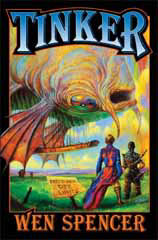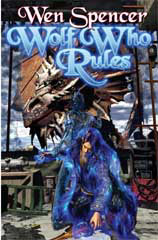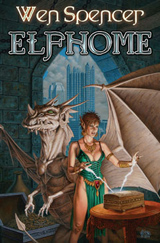MAGIC
Years ago, when I began reading science fiction, I was a nuts-and-bolts, spaceships-and-rayguns sci-fi fan. Then a couple of my favored authors (both female) slipped into sword and sorcery. I tried to follow, but I guess my structured, logical mind just didn’t wanna go there. There seemed no “basis” for magic. It just was, take it or leave it. I left it.
Fast forward 40 years. Times, and technology, and therefore writing, have changed. In the last couple of years, the son has introduced me to four different sci-fi series wherein magic exists. Quantum mechanics/entanglement and cosmic energy, along with parallel dimensions, justify magic, at least to me.
The last for me to read is from an author listed as Ilona Andrews. It’s actually a husband and wife team. She’s Ilona. He’s Andrew. She’s Russian. He’s American. No seductive superspy or licence to kill, she came to San Francisco to attend university, and they met at an English Composition course, where she outscored him. (Where’s a licence to kill when you really need one?) She writes the romance/sex/magic, and he takes care of guns, knives, bombs, vehicles and martial arts.
The son had acquired numbers 1, 3, and 5. Recently he let Amazon fill in numbers 2 and 4, and number 6 will soon be released. I’ll add them to my to-be-read pile, and get to them some time next year.
Two other series are both by the same author, Larry Correia. The Hard Magic group are set in the Roaring Twenties era, a Raymond Chandler-esque alternate-history with Tommy gun-toting hoods, and airships instead of planes. All people range from zero to adept at telepathy, telekinesis, teleportation etc. Only a rare few can synthesize control over more than one talent.
His Monster Hunter series is modern-day and assumes the existence of werewolves, vampires, orcs and the like. Silver-bullet armed groups are paid by the government to keep these away from the general population. Non-threatening species like elves and gnomes are merely confined to reservations which resemble redneck trailer parks. Social commentary, anyone?
The last group are the ones I’m going to (finally) review. A female author has written several books intended for adolescent readers, but in doing so, perhaps unknowingly or unintentionally, she has written above expectations, and produced some adult-grade statements.
The Author – Wen Spencer
The Book(s) – Tinker – Wolf Who Rules – Elfhome
The Review
I’m reviewing three books, because this trilogy of 550-page stories is actually one extended tale across several summer and fall months. They can be read as stand-alone books. Each one is carefully ended, but enjoyment and comprehension of #2 and #3 are greatly enhanced by the previous back-story.
Magic, in these stories, like cosmic rays, is ubiquitous, needing only to be gathered and controlled. Small groups of parallel dimensions hang like bunches of tomatoes on a vine. Those closest to the stalk receive the most magical power. Poor Earth hangs out at the very end, receiving just enough to make magic the stuff of myths and legends.
Apparently a native of Pittsburgh, Spencer puts all of the action there. Magic does what technology does, only faster, better, more powerfully. Technology can harness magic, if you know how and where. The magic is directed with crystals, or computer-printed spell sheets. Of course, it can also be controlled with hand and arm postures, and initiated with voice vibrations, spell words, like the Weirding-module guns in Frank Herbert’s Dune book and movie.
Our teenage heroine’s grandfather produced a satellite which unwittingly causes the city to cycle from Earth to an alternate-Earth known as Elfhome. On each such tomato-Earth in the bunch, a different, though similar, set of flora and fauna have evolved, with a different race at the top of the food-chain.
The magic-rich Elves, while not exactly immortal, live thousands of years. There’s a world where sauroids learned to use magic, and essentially became intelligent dragons. They, and others, can move from world to world.
The author is entranced with Asian culture. She has the heroine in another book move to Japan to become a writer. Aside from the action, these stories are much in the vein of Jonathan Swift’s, Gulliver’s Travels. She uses satire and lampoon as social comment, to show the strengths and weaknesses of various cultures.
The regal and genteel, one-child-per-century Elves are the Japanese. While they make a great show of manners, they are locked into a royal court and cultural rut, too slow to deal with the rapid social changes that inter-world travel has brought to them. Everyone has their place, but, like the caste-ridden India, there is often no-one to fill newly-produced places.
The ill-mannered, pig-based Onihida, breeding faster than rabbits, busily consuming and corrupting their own world, as well as others, are the Chinese. The diverse half-breeds are the Americans, able to use the magic to sprout wings and fly like birds, or trail like bloodhounds.
These are the tales of a wrecking-yard-owning Pittsburgh Cinderella, who rescues, and in turn is rescued by, her Elfin Prince Charming. She uses quick wit and genius level intelligence to defeat the bad guys and save the day. Through them all, the author cogently notes where our societies have come from, and where they might be going.
I found them good, solid reading, with lots of action and plot twists, and a reflection of life.



I’m not a fantasy/magic fan but your description sounds interesting.
LikeLike
Such fare would normally be on the *young* side for me, but Shimoniac bought them and offered them to me when he was finished. They were light, but fun. 🙂
LikeLike
I like books where they make you think about society, but not by coming right out & saying our society sucks! In a neatly crafted tale, it can bring you realizations you may not have had before. Great review!
LikeLike
Thank you muchly! That’s high praise from someone who really knows. 🙂
LikeLike